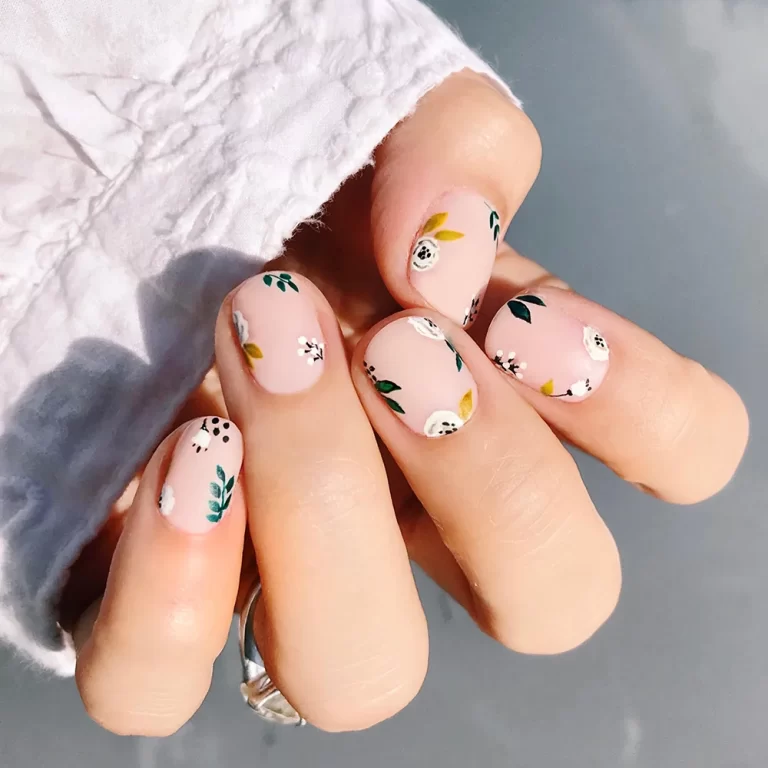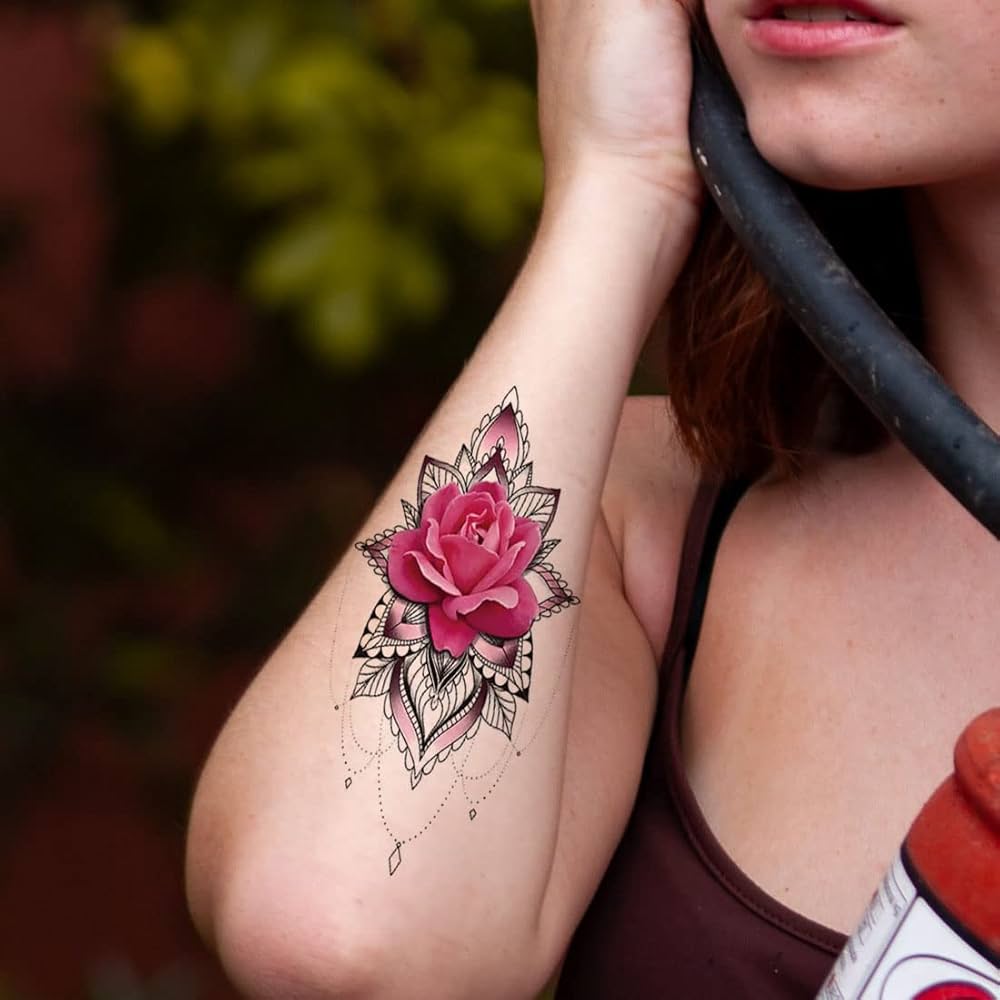
Rose Tattoo Styles Guide: The Symbolism of Rose Tattoos
The Symbolism of Rose Tattoos
Rose tattoos carry deep symbolism, often embodying emotions and ideals. They symbolize love, beauty, and balance. They can also represent the duality of human existence with thorns suggesting pain or loss, and the delicate petals signifying beauty and life. People choose rose tattoo not just for their aesthetic appeal, but because they want to express something deeper about their journey or beliefs. Over time, roses have accumulated various meanings from different cultures.
Historically, roses have ties to Greek mythology where they were associated with Aphrodite, the goddess of love. In Christianity, the rose is often linked to the Virgin Mary, symbolizing purity and heavenly grace. The rose’s association with secrecy and confidentiality, exemplified by the Latin phrase sub rosa (under the rose), depicts another layer of its symbolic heritage. Qualities of bravery, respect, and passion are also encapsulated within this flower’s emblematic spectrum, often informing a wearer’s choice in a rose tattoo design. In modern interpretations, a rose tattoo can also mark significant life events, personal growth, or serve as a tribute to loved ones.
The symbolism of the rose is vast and can be tailored to the individual’s experience, which is what makes rose tattoos a timeless and versatile choice for many. Each rose tattoo is not just a piece of art but a personal emblem with unique significance.
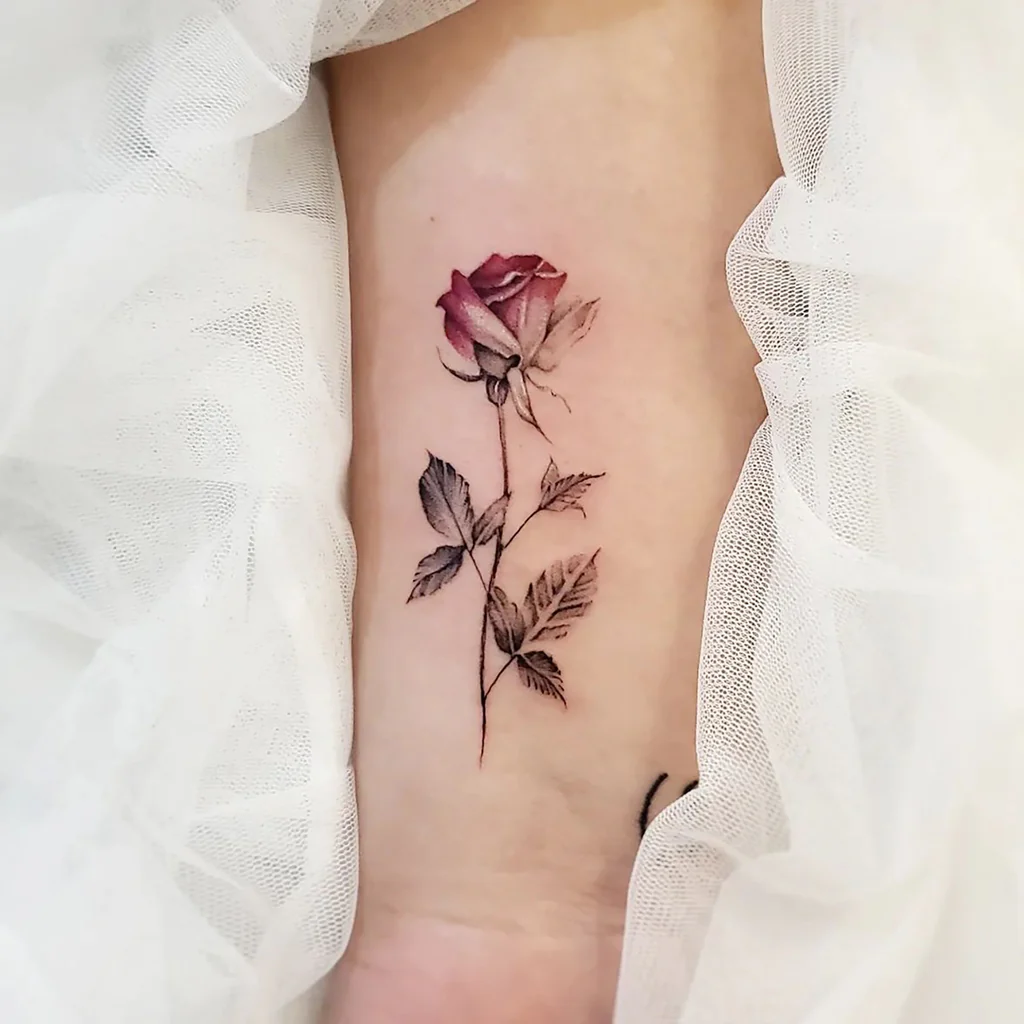
Different Rose Tattoo Design Styles
Choosing the right rose tattoo style is essential for personal expression. It’s about finding the design that speaks to you, matches your aesthetic preferences, and aligns with the symbolism you want to convey. There’s a range of styles to consider, each with its distinct flair and meanings.
Classic American Traditional Rose Tattoos
Classic American traditional rose tattoos are bold and iconic. They feature strong lines, vivid colors, and often incorporate nautical or military themes. These tattoos have a vintage charm and are known for their longevity on the skin. They stand for love and courage, with simple yet powerful design elements.
Realistic Rose Tattoos
Realistic rose tattoos focus on lifelike details. Artists capture every petal, shade, and dewdrop, creating a three-dimensional look. These tattoos are perfect for those who want to capture the rose’s natural beauty. They symbolize a sincere and straightforward appreciation for the rose.
Blackwork Rose Tattoos
Blackwork rose tattoos use solid black ink to create dramatic effects. They range from simple silhouettes to intricate dot work and linework, emphasizing the rose’s form and texture. This style can represent strength, mystery, or elegance in its minimalistic color scheme.
Watercolor Rose Tattoos
Watercolor rose tattoos are known for their smooth, gradient colors without the use of bold outlines. They appear as if painted onto the skin, with a sense of freedom and creativity. These tattoos can symbolize a gentle, artistic spirit and a carefree approach to life.
Geometric Rose Tattoos
Geometric rose tattoos blend the natural beauty of the rose with the precision of geometric shapes. They often involve symmetry and repeating patterns, adding a modern twist to the classic flower. This style suggests a balance between nature and structure, appealing to those who love contemporary designs.
Minimalist Rose Tattoos
Minimalist rose tattoos are all about simplicity and subtlety. They strip down the design to its basic elements, often resulting in a single-line drawing or a small, understated tattoo. These tattoos suit people who prefer a more discreet, yet meaningful, token of beauty and significance.
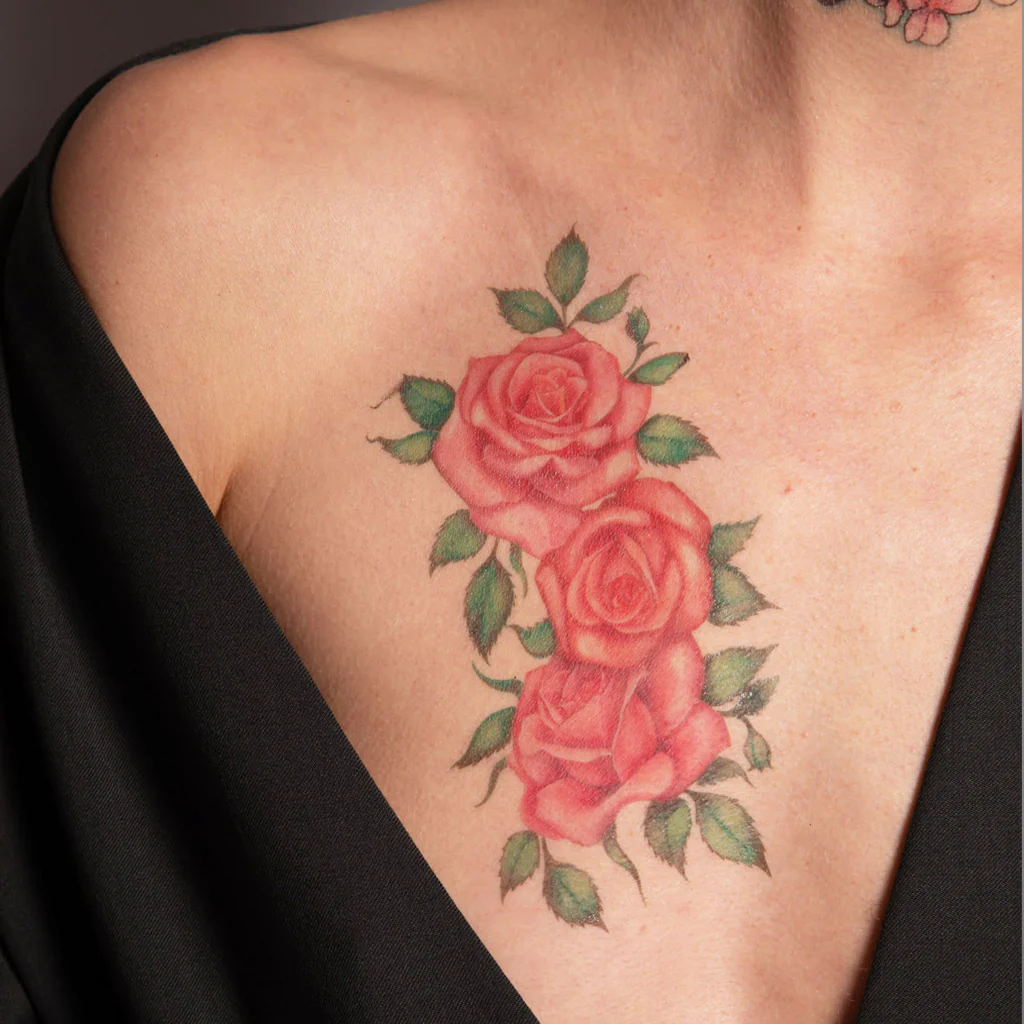
Popular Rose Tattoo Colors and Their Meanings
The color of a rose tattoo can add layers of meaning to the design. Different hues speak to different emotions and symbols, making the choice of color as significant as the design itself.
Red Rose Tattoos
Red rose tattoos are perhaps the most classic and recognized color choice. They symbolize deep love and passion, often connected to romantic feelings. A red rose tattoo is a bold declaration of intense emotions.
Black Rose Tattoos
Black rose tattoos often represent mourning or farewell. They may symbolize loss but can also stand for rebirth or major change. This color suggests a powerful, resilient spirit, embracing transformation or closure.
White Rose Tattoos
White rose tattoos symbolize purity and innocence. They often indicate new beginnings or memorialize a departed loved one in a subtle, respectful way. A white rose can also represent spiritual love and reverence.
Yellow Rose Tattoos
Yellow roses in tattoos can symbolize friendship and joy. They convey warmth, appreciation, and platonic love. A yellow rose tattoo can celebrate a close bond and shared happiness.
Pink Rose Tattoos
Pink rose tattoos generally express admiration and gratitude. They can also reflect a sweet, tender love. This color is often chosen for its delicate and soft appearances, evoking a sense of gentleness.
Blue Rose Tattoos
Blue rose tattoos are quite unique and not found naturally. They symbolize the mysterious or the unattainable. A blue rose might be chosen by someone who appreciates the extraordinary or seeks to provoke curiosity.
Choosing the right color for your rose tattoo is as crucial as the design itself. It allows you to communicate a range of sentiments and meanings deeply personal to you.
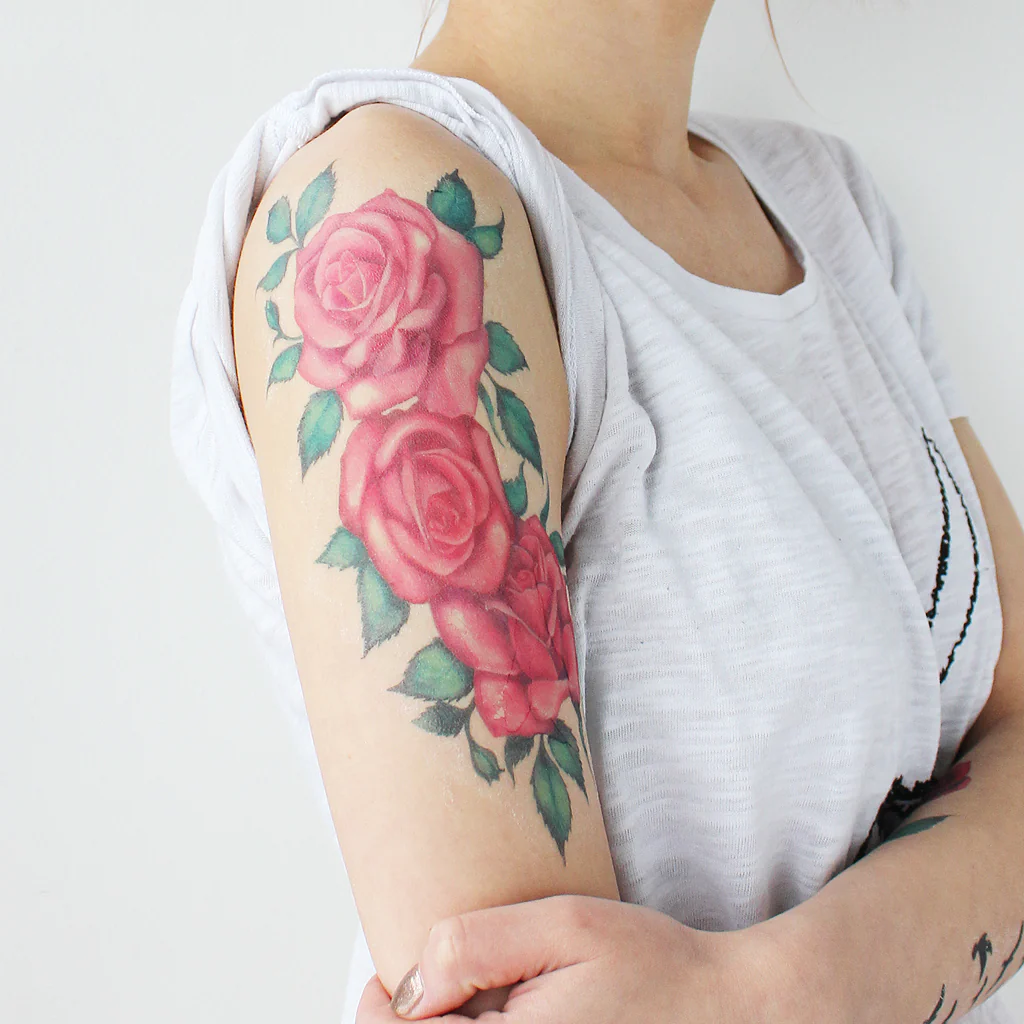
Ideal Placement for Rose Tattoos
Choosing the perfect spot for a rose tattoo is key to showcasing its beauty and significance. The ideal placement can enhance the tattoo’s visibility and ensure it complements your body’s contours. Here are some popular locations:
- Forearm: A rose tattoo here can be easily displayed or hidden. It’s versatile for any size and style.
- Shoulder: This spot is great for a larger rose design and can be connected to a sleeve tattoo.
- Back: A spacious area that allows for elaborate rose tattoos, often combined with other elements.
- Chest: Rose tattoos on the chest are often seen as symbols of love, close to the heart.
- Ankle: A subtle and delicate placement, perfect for a minimalist rose tattoo.
- Wrist: Ideal for small rose designs, the wrist is a spot for personal reminders or statements.
- Thigh: Offers privacy and a big canvas for a detailed, realistic rose tattoo.
When deciding on placement, consider the pain factor as well. Some areas, like the rib cage or ankle, can be more sensitive than others. Additionally, think about your lifestyle and how the tattoo will blend with your wardrobe choices. Wherever you decide to place your rose tattoo, ensure it’s a spot that has personal significance and reflects the symbolism you wish to carry with you.

Customizing Your Rose Tattoo Design
When it comes to making your rose tattoo unique, customization is key. The design should reflect your personal story or the message you want to convey. Here’s how you can customize your rose tattoo design to ensure it’s one-of-a-kind:
- Incorporate Symbols: Blend other symbols that hold meaning for you with the rose. This could be anything from a date, a name, to a celestial body.
- Mix Styles: Combine different tattoo styles. A watercolor rose might emerge from a geometric stem, for example. This creates a fusion of traditions and modern concepts.
- Adjust the Scale: Play with the size of your tattoo. A large, detailed piece makes a different statement than a small, discreet rose.
- Personalize Colors: Choose colors that resonate with you beyond their traditional meanings. A favorite shade or a color that holds personal memories can add depth to the design.
- Unique Positioning: Think about how the tattoo sits on the body. The way a rose wraps around an arm or cascades down a shoulder can change the tattoo’s dynamics.
- Innovative Shading: Shading can dramatically alter the tattoo’s look. Soft shading might suggest a tender meaning, while heavy shading can give a more solemn tone.
By considering these elements, you can tailor your rose tattoo to be an authentic expression of your inner self. Your tattoo artist can help guide these choices to ensure the final design is both personally meaningful and aesthetically pleasing. Remember, this is a form of art that will be with you for life, so take the time to make it special.

Aftercare for Rose Tattoos
Proper aftercare is crucial for a new rose tattoo to ensure it heals well and retains its beauty. Here are some key steps to follow:
- Keep it Clean: Gently wash your tattoo with mild soap and lukewarm water. Pat it dry with a soft towel.
- Moisturize: Apply a thin layer of fragrance-free moisturizing ointment regularly. This keeps the tattoo moist and promotes healing.
- Avoid Sun Exposure: Keep your tattoo out of direct sunlight. Sunlight can fade the tattoo and slow down the healing process.
- Don’t Pick or Scratch: As your tattoo heals, it will start to itch and flake. Do not scratch or peel the skin.
- Wear Loose Clothing: Choose loose clothing that won’t rub against your tattoo. This reduces irritation and allows the skin to breathe.
- Stay Hydrated: Drink plenty of water. Good hydration helps your skin heal faster and stay healthy.
- Avoid Swimming: Stay out of pools, lakes, and the ocean during the healing period. Water can harbor bacteria that might infect the tattoo.
- Follow Your Artist’s Instructions: Each tattoo artist might suggest specific care tips. Always follow their guidance.
Healing times can vary, but generally, a tattoo takes about two weeks to heal on the surface and up to two months to heal completely. Watch for any signs of infection such as excessive redness, swelling, or pus. If you notice any of these signs, consult a healthcare provider promptly.
